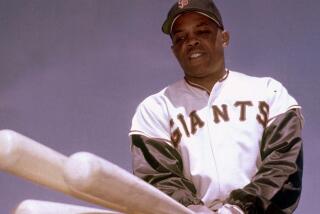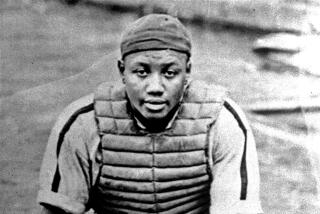This Minor League Hero’s Rough Ride Is Finally Over
- Share via
Becoming the only man to lead the International League in home runs four times during its more than 100-year history should have made Howie Moss something beyond a mere provincial hero.
The Baltimore Orioles recognized him as one of their most awesome power hitters, yet his achievements never received the acclaim they deserved.
Was that a tough ultimatum dictated by the fickle winds of fate, or was he arbitrarily labeled a minor-league home run king who couldn’t produce at the major-league level? It all seems unfair, considering the numbers he put up for the Orioles more than four decades ago.
Moss carried the colorful tag of “Howitzer Howie,” a right-handed pull-hitter who came out of the dugout swinging. He led the International League in homers with the Orioles in 1944, 1946, 1947 and 1948 with 27, 38, 53 and 33.
In 1945, during the war, he was in the Navy at the Bainbridge (Md.) Training Station. Moss was later with the Cincinnati Reds and Cleveland Indians in 1946 for brief looks but was turned back each time. It was a career disappointment, yet he never complained that the game hadn’t rewarded him with the thorough chance it had offered others with less impressive credentials.
Moss, age 70, died unexpectedly at his home in Baltimore Sunday and is to be buried Wednesday. He was the first of three Orioles to receive International League Most Valuable Player Awards in the ‘40s--Moss in 1944, Sherman Lollar in 1945 and Eddie Robinson in 1946.
A third baseman and outfielder with a strong arm, Moss hit the ball high and took advantage of a short left field in Baltimore’s Municipal Stadium that had been converted from football to baseball after Oriole Park burned down on July 4, 1944.
Two of Moss’ former Oriole teammates, Ray Flanigan and Milt Stockhausen, offer fond recollections.
“He was a great guess hitter, one of the best I ever saw,” Stockhausen said. “He hit a lot of curveballs for home runs and had the right stroke for that fence in the stadium. It was about 280-feet down the line but went out sharply toward center field.”
Flanigan, like Stockhausen and Moss, went to the Indians from the Orioles. “I don’t know what happened that he didn’t make it,” Flanigan said. “Maybe he couldn’t handle the good fastball up and in, but that goes for a lot of hitters. I do remember he’d chase a bad curveball when he got behind in the count but, again, so many others do that, too.”
It seems unfair that the records categorize Moss with such other home run champions as Joe Hauser, Buzz Arlett and George Puccinelli--all of whom wore out International League pitching yet didn’t do it in the majors.
They hit a ton but never had the advantage of a ready-made job situation in the big leagues, which at the time was limited to 16 clubs. Talent was evaluated in a severe and often discriminating manner.
Moss came to the Orioles after an unusual minor-league career that saw him start for Greenwood, Miss., in 1936 in the Cotton States League and suddenly quit for three years to play for an “outlaw” team in his hometown of Gastonia, N.C. It wasn’t until 1941 that he got reinstated and returned to organized baseball.
The 1944 International League campaign saw the Orioles win the pennant, playoffs and Little World Series as Moss topped the league in home runs, 27; runs-batted-in, 141; doubles, 44, and hits, 178. Injuries were a problem, always seeming to occur when opportunity beckoned.
“I never believed in alibiing,” he once said, “but every time I got a chance to go somewhere I either wound up on crutches or in a cast.”
More to Read
Go beyond the scoreboard
Get the latest on L.A.'s teams in the daily Sports Report newsletter.
You may occasionally receive promotional content from the Los Angeles Times.










